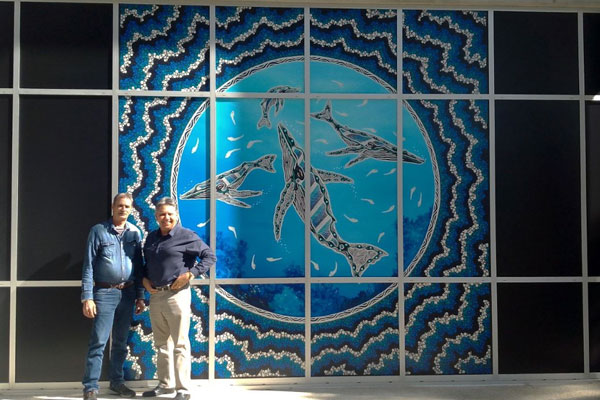
Artist Troy Little, with Geoffrey Binge, next to his artwork at RBWH’s main entrance.
Earlier this month, Aboriginal artist Troy Little came to see his art in full display at the main entrance of RBWH. Mr Little is from Bundjalung country (Northern Eastern NSW) and now lives bayside in Brisbane, often incorporating whales and other marine life in his art.
Having created art for at least three decades, Mr Little is the only Aboriginal or Torres Strait Islander artist he is aware of who incorporates glow-in-the-dark effects into his works. “Every animal has its spirit,” Mr Little said, “making the work glow is how I can bring that spirit to life without changing the animal.”
The large whale artwork at the main entrance is a copy of Mr Little’s original artwork that glows in the dark and is on display in the Gynaecological admissions area of the Emergency and Trauma Centre.
“I used blues because they are calming colours, to help calm people down who find themselves in the hospital.”
Aboriginal and Torres Strait Islander artwork on the walls of RBWH creates a calming and welcoming place for all, but it also assists in creating a culturally safe place for Aboriginal and Torres Strait Islander patients and visitors.
“This art helps say, ‘welcome’,” RBWH Cultural Capability Officer Geoffrey Binge said. “It also says to our Aboriginal and Torres Strait Islander patients that this is a culturally safe place for them.”
Cultural safety is an important part of improving Aboriginal and Torres Strait Islander peoples’ health and wellbeing outcomes.
Metro North’s Health Equity Strategy 2022-2025 highlights delivering ‘Culturally Safe and Responsive Healthcare Services’ among the key performance measures on ending institutional racism and achieving life expectancy parity for Aboriginal peoples and Torres Strait Islander peoples by 2031.
Health equity is like art — it can’t be rushed. The strategy outlines how working to tight deadlines limits Aboriginal and Torres Strait Islander co-design and engagement. Instead, it’s about listening, learning and taking the journey together to create a culturally safe health system.